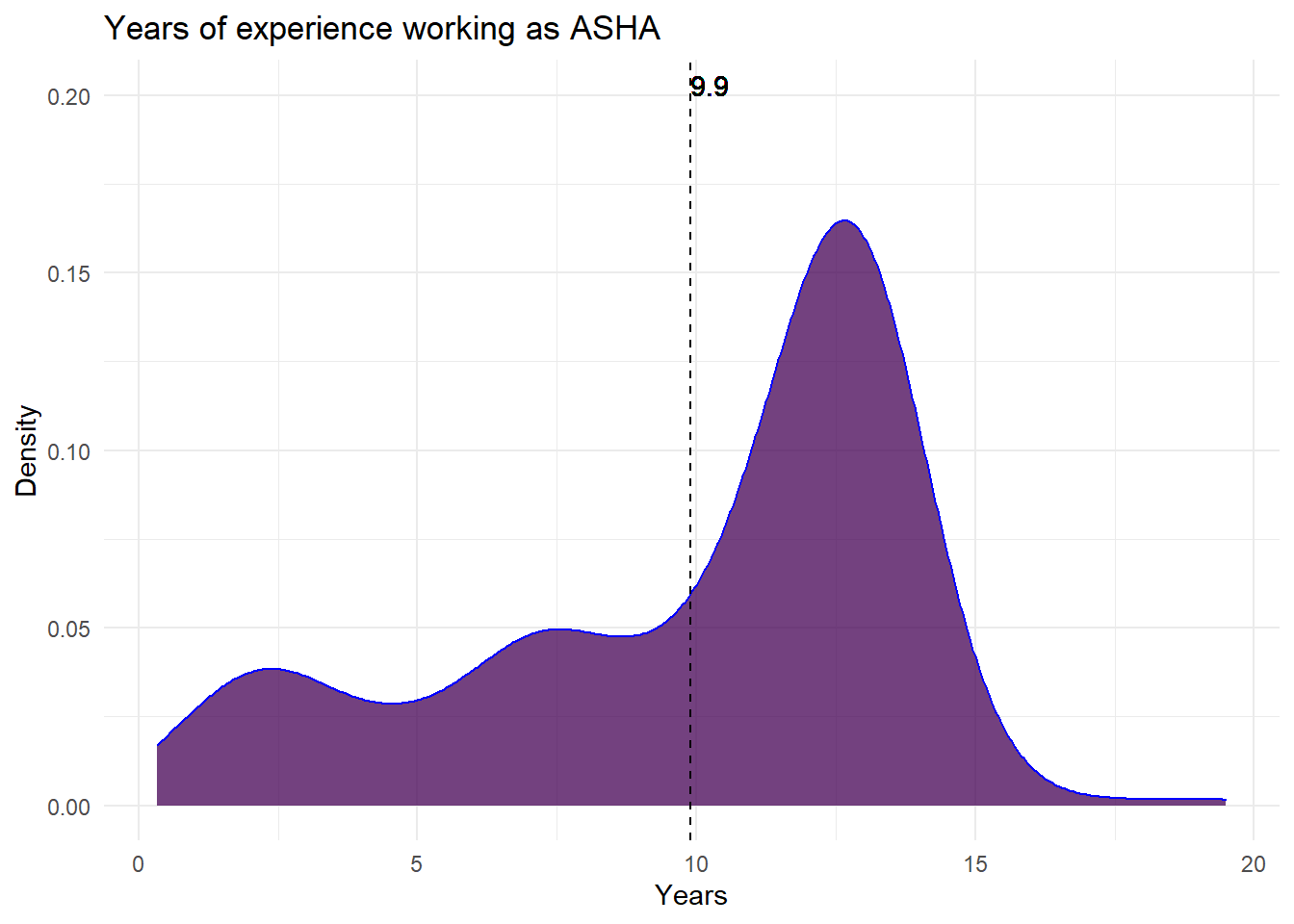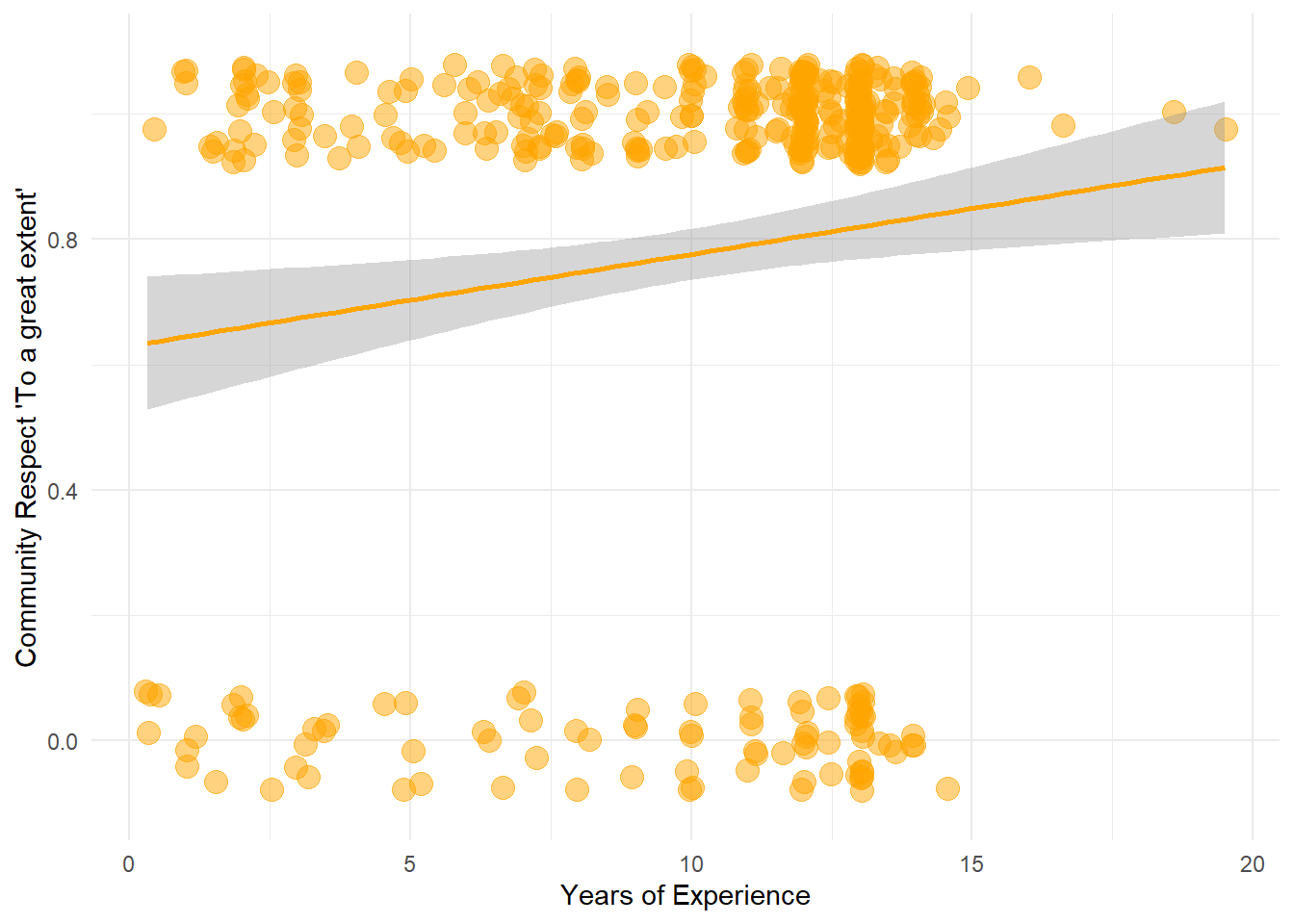7.3 ASHA Training and Experience Change ASHA’s own Maternal Behavior
An emphasis of Project RISE is the lived-experience of the ASHA. Here we examine how time spent as an ASHA influences the uptake of biomedically recommended behaviors.
The ASHAs in our sample have from 1 to almost 20 years of experience as an ASHA with the majority between 10 and 15 years (Figure 7.7).

Figure 7.7: Years of experience in ASHA role
Because we also have information on the ASHA’s most recent birth experience, we can examine the degree to which time spent as an ASHA has affected the uptake of health behaviors.
In the overview of behaviors presented above, we notice several differences between ASHAs and Mothers in the uptake of recommended biomedical practices (Table 7.2).
Here we take a more in depth look where we control for the time spent as an ASHA and place both samples in the same regression analysis (Table 7.5).
We fit two kinds of models to assess how time spent as a mother since becoming an ASHA affected the uptake of select behaviors. One looks simply at each target health behavior and the time spent as an ASHA since last birth and the second includes controls for age and education. In the table we report only the effect on time as mother. The table reports odds ratios, which means that if the OR is greater than 1, the behavior was more likely to have happened than not happened for each additional year as an ASHA since last birth. If the OR is less than one the behavior was less likely.
In general, the controls of age and education did not affect the results for each behavior. The results of this model suggest that each year spent as ASHA:
- increases the odds that she fed colostrum to her most recent child by 10%
- increases the odds that she had an institutional delivery by 16%
- increases the odds that she had a timely ANC registration by over 20%
Time spent as an ASHA also increased the odds of increasing the diet, as recommended, during pregnancy and postpartum.
Perhaps most interesting is that time spent as an ASHA had no effect on the likelihood of concealing the pregnancy.
We also included some neutral behaviors regarding the Dai because we interested in connections between the Dai and ASHA. Time spent as an ASHA had no relationship with having a Dai visit during pregnancy, but lowered the odds that ASHAs would call a Dai for delivery, when they start labor, or that they would have a Dai visit after delivery.
| Behavior | Model1_OR | Model1_pval | Model2_OR | Model2_pval |
|---|---|---|---|---|
| Conceal pregnancy | 1.02 | 0.5121 | 0.99 | 0.8386 |
| Fast while pregnant | 0.96 | 0.0504 | 0.99 | 0.8164 |
| Work while pregnant | 0.94 | 0.0003 | 0.95 | 0.0309 |
| Cordstump treatment | 0.89 | 0.0000 | 0.91 | 0.0002 |
| Bathing newborn | 0.92 | 0.0000 | 0.96 | 0.0885 |
| Avoiding cereal after delivery | 1.00 | 0.7972 | 1.00 | 0.8346 |
| ANC registration | 1.26 | 0.0000 | 1.22 | 0.0000 |
| Institutional delivery | 1.16 | 0.0000 | 1.10 | 0.0001 |
| Increase diet pregnancy | 1.07 | 0.0012 | 1.07 | 0.0037 |
| Increase diet postpartum | 1.03 | 0.1218 | 1.06 | 0.0081 |
| IFA tablets | 1.14 | 0.0000 | 1.12 | 0.0000 |
| Colostrum | 1.10 | 0.0000 | 1.07 | 0.0092 |
| TIBF | 1.08 | 0.0000 | 1.06 | 0.0076 |
| Dai visit during pregnancy | 0.99 | 0.6470 | 0.98 | 0.4518 |
| Call Dai for delivery | 0.93 | 0.0001 | 0.94 | 0.0044 |
| Dai visit after delivery | 0.88 | 0.0000 | 0.90 | 0.0006 |
7.3.1 ASHA Respect with Time as an ASHA
We also quickly examine how ASHA experience affects how their communities and families perceive them. The Figure shows a bi-variate correlation between the probability that their community respects them ‘to a great extent’ and their experience as an ASHA, showing that community respect may increase.
Note, however, that if we fit a model with controls for age and education that experience still has the largest effect but none of the three are ‘significant.’
Likewise, with family perception using a similar approach, the age of the ASHA has a larger effect than does the years of experience she has as an ASHA.

Figure 7.8: The probability that an ASHA’s Community respects her to a great extent as a function of her years of experience.